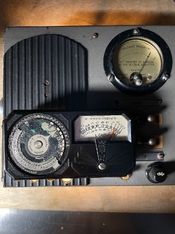Stephen Benskin
Member
I appreciate your hard calculations. Could you sum up in layman's terms what it all means?
It’s about the relationship between the camera setting and what the meter reads.
The equation below is the reflected and incident exposure meter calibration equation. On the left is the camera setting, the middle is the calibration equation for the reflective exposure meter that is concerned with the Luminance of a subject and film speed, and the right equation is the calibration equation for the incident exposure meter with the scene Illuminance and the film speed.
By using the Sunny 16 rule where f/16 at 1/film speed is the exposure, it’s easy to determine the Luminance and Illuminance values, since under the Sunny 16 rule, the shutter speed and film speed cancel each other out, we are only left with a few variables. The variables K and C are known for their base value of 1.16 cd/ft2 and 30 footcandles. To convert to meters, just multiply by 10.76.
What we get is the Luminance value for f/16 at 1/film speed is:
297 cd/ft2 or 3197 cd/m2
The illuminance is:
7680 footcandles or 82,667 lx
Illumination falls on a subject and is reflected toward the subject. By knowing the value of the light falling on the subject and the value of the light reflecting off it, we can determine the Reflectance of the subject. Reflectance implies a Lambertian surface which is considered a theoretically perfect reflector. Its formula is:
What would the Reflectance need to be to produce a value of 297 cd/ft2 from an Illuminance of 7380 footcandles? Plug in the values determined from the calibration equations and
The Reflectance of the subject that will produce a Luminance of 297 cd/ft2 from an Illuminance of 7680 footcandles is 12%. This is good for a metered subject of a single value. Averaging exposure meters will vary depending on the distribution and Reflectance of the values in the scene. Theoretically, under the same Illuminance, the reflected meter will have the same settings as the incident meter when the subject is at 12% Reflectance. To be clear, the meter is reading the Luminance coming off the subject, not the Reflectance. There are a number of variables that can affect the correlation. The meter doesn't care what the Reflectance of the object it is pointed at. For f/16 at 1/film speed, it is looking for 297 cd/ft2.
A short cut is to just use the constants.
Last edited:



